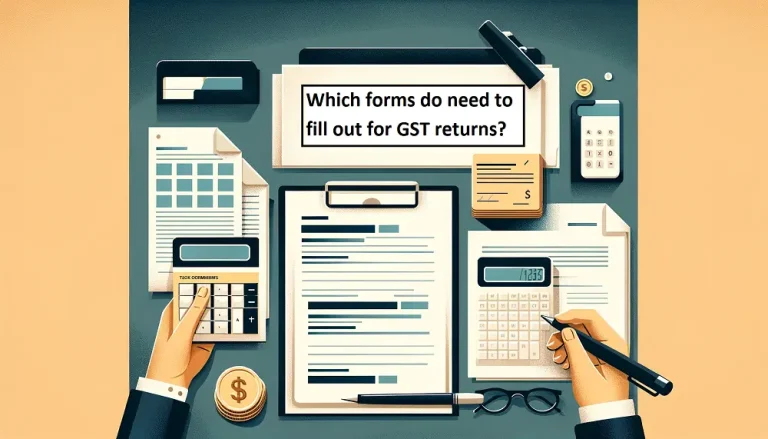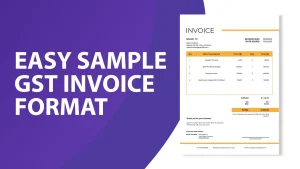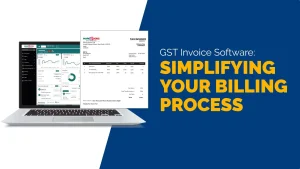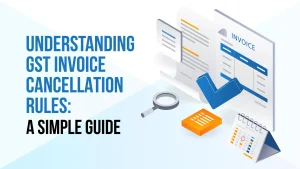Let’s talk taxes! You’ve probably heard about GST, the Goods and Services Tax, right? It’s like the boss of all indirect taxes, simplifying things for businesses and folks. Now, why is it crucial to chat about GST returns? Well, that’s where we spill the beans on the money matters – keeping things clear and legal. In this blog, we’ll break down why filing GST returns is a big deal and explore the forms you need to know. Think of it as your guide to navigating the tax world without getting lost in the paperwork. Stick around, and we’ll make sure it’s all crystal clear!
Overview of GST Return Forms:
Understanding Different GST Return Forms and Their Purposes:
GSTR-1: Sales Report
- Purpose: This form tells the government what you sold in a specific time—details like what, how much, and the tax on it.
- This is where businesses share details about what they’ve sold. It’s like a sales diary where they note down the types of things they sold, how much, and how valuable they were.
GSTR-2: Purchase Report
- Purpose: It’s about what you bought from others. It shows what you purchased, helping the government see your costs and the taxes you paid.
- Businesses keep track of what they bought in a specific time. This report is crucial because it helps them get back some of the taxes they paid when buying things.
GSTR-3: Monthly Summary
- Purpose: GSTR-3 is the big picture of your month. It takes info from GSTR-1 and GSTR-2, giving an overall view of your sales, purchases, and the tax you owe.
- Think of this as a monthly summary. It brings together the sales report (GSTR-1) and the purchase report (GSTR-2) into one big picture. It’s like seeing the whole month’s business activity in one document.
GSTR-4: Quarterly Report for Small Businesses
- Purpose: For small businesses, GSTR-4 is a report every three months. It covers sales, purchases, and the taxes you owe, offering a more extended look at your money matters.
- Small businesses use this form every three months. It’s like their business report card but for a longer period. It’s designed to make things simpler for businesses that don’t have huge sales.
GSTR-5: Report for Foreign Businesses
- Purpose: If your business is from another country but works here, GSTR-5 reports your activities—what you sold, bought, and owe in taxes during your stay.
- If a business from another country sells things in India, they fill out this form. It’s their way of saying, “Hey, this is what we sold in your country,” making sure they follow the tax rules here.
GSTR-6: Report for Those Sharing Credits
- Purpose: GSTR-6 helps businesses with multiple branches share tax credits. It shows how these credits are spread among different units.
- Sometimes, big businesses have different branches. This form is like a record book for them. It shows how they share tax benefits among their different places.
GSTR-9: Yearly Summary
- Purpose: GSTR-9 is your annual business report. It sums up all your sales, purchases, and tax activities for the whole year.
- Once a year, businesses sit down and look at everything they did. This form is like a big, detailed summary of the entire year. It helps them see the whole journey of buying and selling for the past twelve months.
GSTR-9C: Yearly Check
- Purpose: GSTR-9C double-checks. It ensures the info in GSTR-9 is right and matches your records, keeping your financial data accurate.
- This is a careful check. Businesses want to make sure that the big yearly summary (GSTR-9) matches perfectly with their detailed financial statements that have been audited. It’s like making sure all the numbers add up correctly.
These forms help you share your business details with the government, making sure everyone knows what’s happening with your money throughout the year.
Importance of Filling Correct GST Return Forms:
Filling forms right is super important. If you make mistakes, there can be big problems.
First, you might get in trouble with the law. Governments need accurate info. If your details are wrong, you could face fines or other punishments, especially with things like taxes.
Businesses also use the info from forms. If it’s wrong, things can get messed up. This can cause money issues and make people or companies look bad.
Getting forms wrong can also slow things down. Whether it’s a job application or something else, mistakes mean delays. This can be annoying and cause problems for everyone involved.
So, always double-check your forms. It’s not just about rules; it’s about avoiding trouble, keeping things smooth, and making sure everything works out well.
Tax Declaration Forms:
Tax Declaration Forms are like organized papers that businesses use when dealing with a tax called GST. These forms help in telling the government about the money a business makes and spends, along with the taxes it pays. Let’s break it down:
About GST Returns: GST returns are like reports that businesses regularly give to the tax people. They share details about what they sold, bought, and the taxes they paid. Tax Declaration Forms are the official papers used to share all this information.
Why Accuracy is Important:
Making sure the information on these forms is correct is really, really important. Here’s why:
- Following the Rules: Correct info helps businesses stick to the rules. It keeps them away from trouble and fines that come when the details are wrong.
- Money Check: The government uses this info to check how much money is coming in from different businesses. Having the right details makes sure everyone is paying their fair share.
- Being Trustworthy: Getting the numbers right shows that a business is honest and trustworthy. This builds trust with customers, suppliers, and people who invest in the business.
- Avoiding Problems: If the details are wrong, the government might start asking questions. Keeping everything accurate helps businesses avoid these kinds of problems.
- Planning Ahead: The right tax details are like a map for businesses. They help in planning and deciding where the business should go next. It’s like having a clear path for making good decisions.
Tax Declaration Forms are not just pieces of paper. They are like a business’s report card to the government. Getting the details right is super important to avoid trouble, build trust, and plan for a successful future.
Common Mistakes to Avoid:
Common Mistakes to Avoid When Filling GST Returns:
Error in Details Entry:
- Mistake: Making mistakes like typing the wrong invoice numbers or amounts.
- Tip: Before you hit submit, take a moment to review and make sure all the details are correct.
Mixing up GSTR-1 and GSTR-3B:
- Mistake: Getting confused between the numbers you put in GSTR-1 and GSTR-3B.
- Tip: Keep it simple by regularly checking and comparing these two reports to catch any differences.
Forgetting Reverse Charge:
- Mistake: Not remembering to include transactions under Reverse Charge.
- Tip: Don’t leave out these transactions – make sure to include them when you fill out your return.
Not Checking with Accounts:
- Mistake: Not looking at your financial books when dealing with GST data.
- Tip: Keep it consistent by always double-checking your GST figures against your accounts.
Late Filing:
- Mistake: Missing the deadline for filing your GST return.
- Tip: Avoid late fees by setting reminders for filing dates and making sure you submit on time.
Ignoring Tax Credit:
- Mistake: Forgetting to claim eligible Input Tax Credit (ITC).
- Tip: Make sure you’re getting all the credit you’re eligible for by being aware of what counts and claiming it correctly.
Incomplete Documents:
- Mistake: Not attaching necessary documents when you submit your return.
- Tip: Keep it organized by making sure you attach all the documents needed along with your return.
Not Doing E-Invoicing:
- Mistake: Not following the rules for e-invoicing.
- Tip: Keep it digital and compliant by generating e-invoices according to the rules.
Skipping Amendments:
- Mistake: Not correcting errors through amendments.
- Tip: Don’t let mistakes slide – fix them by filing amendments promptly.
Incomplete GSTR-9 Information:
- Mistake: Leaving out details when filling out your annual return (GSTR-9).
- Tip: Make it complete by filling in all the information accurately for a thorough and correct annual report.
By being mindful of these common mistakes and following these straightforward tips, businesses can make sure their GST returns are accurate and in line with regulations.
Tips for Easier Filing:
Making GST Filing Easier:
- Go Digital: Use computer programs or apps made for GST filing. They do the hard work and keep things accurate.
- Keep Papers in Order: Put all your bills and receipts in order. It makes finding them easy when you’re filing.
- Stay Updated: Check for any new rules about GST. Look online or ask for updates so you’re following the latest rules.
- Watch Online Guides: There are videos online that teach you how to do GST filing. Watch them to understand the steps.
- Plan Before Dates: Mark the dates when you have to file GST on your calendar. Plan a bit before so you’re not in a rush.
- Check Your Work: Before you press the submit button, double-check all your numbers. Make sure they match your bills and receipts.
- Get Help if Needed: If you’re confused, ask someone who knows about taxes. They can help you understand the tricky parts.
- Use Offline Tools: If the internet is not always there, use apps that work without it. They can help you get ready even without internet.
- Save Your Data: Keep a copy of all your GST info safe. This helps in case you lose it or something goes wrong.
- Ask the Government: If you’re stuck or don’t understand something, call the government helpline. They can help you out.
By doing these easy steps and using computer programs, you can make doing your GST filing simpler and get it right.
Also read – A Simple Guide to Making a Board Resolution for GST Registration
Conclusion:
To wrap it up, doing your GST returns right is super important for your business. Those different forms you fill out? They’re like your business report cards for the government. Get the details correct to avoid problems and keep everything running smoothly. If you’re unsure, ask someone who knows taxes or check with the government helpline. Don’t forget to file on time and stay updated with the rules – it’s like a roadmap for a hassle-free tax journey!
Frequently Asked Questions
What is GST and how does it work?
GST, or Goods and Services Tax, is a unified tax system implemented by the government to replace multiple indirect taxes. It applies to the supply of goods and services across India and is levied at each stage of the supply chain.
Who is required to file GST returns and why?
Any business or individual registered under GST must file GST returns to report their sales, purchases, and tax liability to the government. Filing GST returns is mandatory to ensure compliance with tax laws and to claim input tax credit.
What are the different types of GST returns and their purposes?
GST returns come in various forms, each serving a specific purpose. These include GSTR-1 for outward supplies, GSTR-3B for monthly summary returns, GSTR-4 for composition dealers, and GSTR-9 for annual returns.
How frequently do I need to file GST returns and what are the deadlines?
The frequency of filing GST returns depends on the taxpayer’s turnover and registration type. Returns can be filed monthly, quarterly, or annually, with specific due dates set by the government.
What information is required in GST returns and how do I gather it?
GST returns require detailed information on sales, purchases, input tax credit, and tax liability. This information can be obtained from invoices, purchase registers, and accounting records maintained by the taxpayer.
What is the process for filing GST returns and where can it be done?
GST returns are filed online through the GST portal using the taxpayer’s registered credentials. The process involves logging in, entering relevant data, and submitting the return electronically to the GSTN (Goods and Services Tax Network).
What are the consequences of not filing GST returns on time?
Late filing of GST returns can lead to penalties, interest charges, and legal repercussions. It may also result in the loss of input tax credit and compliance issues with tax authorities.
Can GST returns be revised after filing and under what circumstances?
Yes, GST returns can be revised within a specified period after filing to correct errors or omissions. However, revisions should be made only for genuine mistakes and not for intentional manipulation of data.
Are there any exemptions or special provisions for certain taxpayers regarding GST returns?
Yes, certain categories of taxpayers, such as small businesses under the composition scheme or those with nil tax liability, have simplified compliance requirements and may be exempt from filing certain GST returns.
Where can I seek assistance or guidance for filing GST returns?
Tax professionals, chartered accountants, and GST helpdesks established by the government can provide guidance and support to taxpayers regarding the filing of accurate GST returns and compliance with GST laws and regulations.




